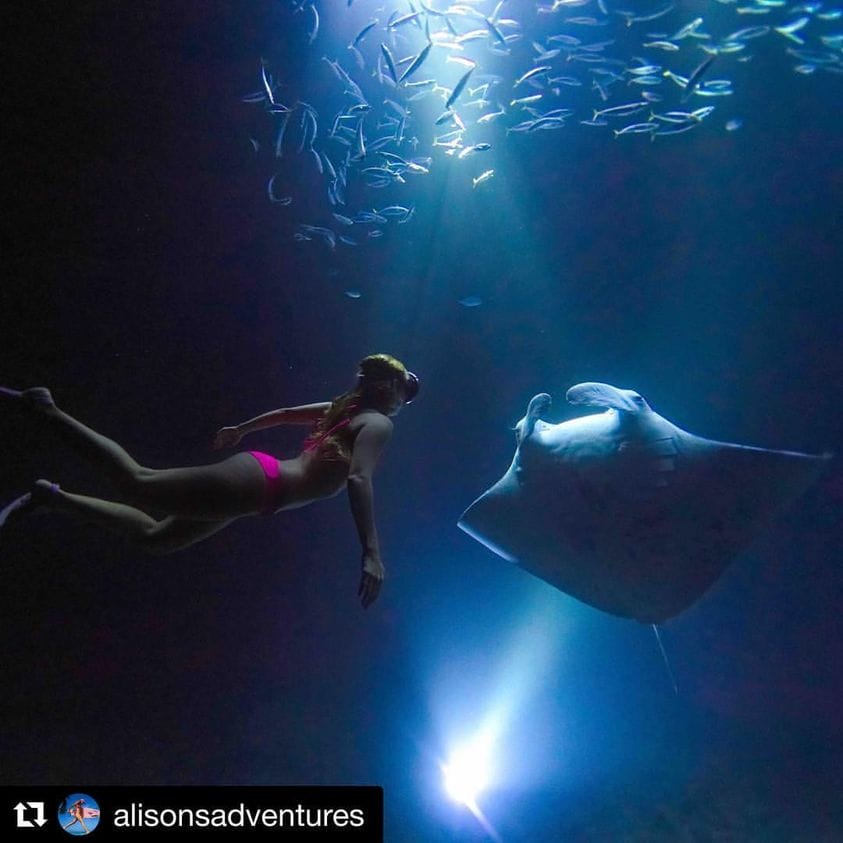National Geographic on the huge and beautiful Manta Ray. Our manta ray tours are the best on the Big Island with the most fun and professional staff. Our night manta ray tours bring you as close as safely possible to the graceful creatures and is an experience of a lifetime!
Manta rays—highly intelligent and highly threatened—are the largest rays in the world.
The sea creatures live in tropical, subtropical, and temperate ocean waters across the globe. “Manta” means blanket or cloak in Spanish, describing the look of the animals’ large, flat, diamond-shaped bodies, which are characterized by triangular pectoral fins. Manta rays have two horn-shaped fins protruding from the front of their heads, which has also given them the nickname “devil fish.”
For decades, scientists thought there was just one species of manta ray. In 2008, researchers discovered that there are actually two distinct species: the reef manta ray, which tends to live along coastlines in the Indo-Pacific, and the giant oceanic manta ray, which lives in all the world’s major oceans, spending most of its life far from land.
While the smaller reef manta has an impressive wingspan of about 11 feet wide on average, the giant oceanic manta ray—the largest species of ray—can have a wingspan of up to 29 feet.
Habitat and feeding
Both species of manta ray are filter feeders: they swim with their mouths wide open, drawing in zooplankton and krill, which they sift through rows of tiny rakes that line their mouths called gill plates. They use creative techniques when feeding, often doing repeated somersaults to stay in a single spot that is packed with krill, or chain-feeding—following each other in a circle, mouths open, to create a cyclone effect, trapping food in a spiral.
Giant manta rays live alone or in small groups, typically congregating to feed. They’re considered predators and hunt deep below the surface of the sea.
Manta rays make regular visits to cleaning stations—spots on a coral reef where sea animals go to be cleaned by smaller creatures—where they stay still for several minutes while cleaner fish remove parasites and dead skin. Many individual manta rays return to the same stations over and over.
Intelligence
Manta rays have the largest brain-to-size ratio of any cold-blooded fish. Studies have shown that manta rays may recognize themselves in the mirror, an ability indicative of high cognitive function, also shown by dolphins, primates, and elephants.
Studies have also shown that manta rays are able to create mental maps of their environment, through smell and visual cues, indicating highly developed long-term memory.
Reproduction
Female manta rays hit sexual maturity at around eight to 10 years old and tend to give birth once every couple of years, usually to one pup, or occasionally two. Pregnancy lasts about 12 to 13 months and manta rays give birth to live pups. Babies look like smaller version of adult manta rays when born and can immediately survive without parental care.
Manta rays can live for 50 years.
Threats
Both sub-species of manta ray are classified as vulnerable by the IUCN. Their greatest threat is overfishing. Because they’re long living and slow to reproduce, localized populations have a difficult time bouncing back when fished. Manta rays are fished for their meat, and, increasingly, their gill plates. In demand for Chinese medicine, they’re said to help with everything from increasing blood circulation to curing chickenpox, despite a lack of scientific evidence. They’re also considered by some to be a delicacy. Thousands of manta rays are killed each year for their plates, in a trade estimated to be worth $30 million.
Since 2011, manta rays have been protected in international waters by the Convention on Migratory Species, an international treaty that protects migrating wild animals. In addition, several countries including Ecuador, Peru, Mexico, the Philippines, and New Zealand have fishing bans in place.
In 2014, Indonesia, home to the world’s largest manta ray fishery, banned fishing and trade of the creatures, pointing to a far more lucrative reason to keep them alive: tourism. Swimming with rays, one study estimates, generates so much revenue for local economies that a single ray in a tourist hotspot can generate up to one million dollars in its lifetime—but is worth only $500 dead.















